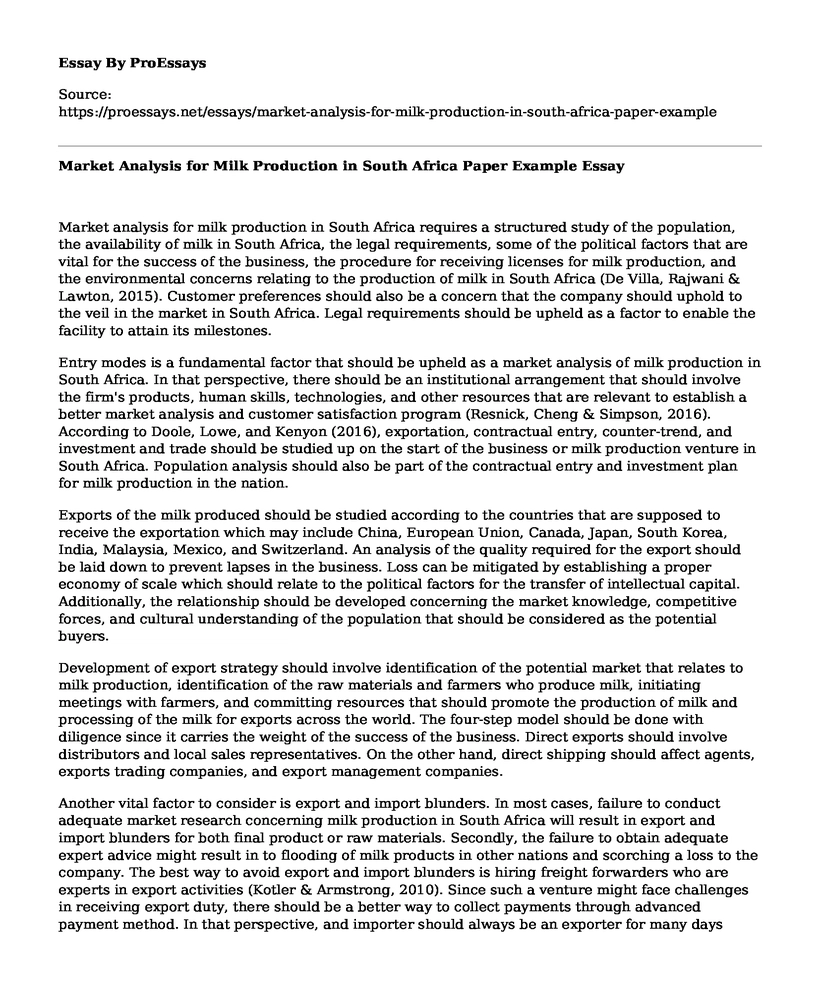Market analysis for milk production in South Africa requires a structured study of the population, the availability of milk in South Africa, the legal requirements, some of the political factors that are vital for the success of the business, the procedure for receiving licenses for milk production, and the environmental concerns relating to the production of milk in South Africa (De Villa, Rajwani & Lawton, 2015). Customer preferences should also be a concern that the company should uphold to the veil in the market in South Africa. Legal requirements should be upheld as a factor to enable the facility to attain its milestones.
Entry modes is a fundamental factor that should be upheld as a market analysis of milk production in South Africa. In that perspective, there should be an institutional arrangement that should involve the firm's products, human skills, technologies, and other resources that are relevant to establish a better market analysis and customer satisfaction program (Resnick, Cheng & Simpson, 2016). According to Doole, Lowe, and Kenyon (2016), exportation, contractual entry, counter-trend, and investment and trade should be studied up on the start of the business or milk production venture in South Africa. Population analysis should also be part of the contractual entry and investment plan for milk production in the nation.
Exports of the milk produced should be studied according to the countries that are supposed to receive the exportation which may include China, European Union, Canada, Japan, South Korea, India, Malaysia, Mexico, and Switzerland. An analysis of the quality required for the export should be laid down to prevent lapses in the business. Loss can be mitigated by establishing a proper economy of scale which should relate to the political factors for the transfer of intellectual capital. Additionally, the relationship should be developed concerning the market knowledge, competitive forces, and cultural understanding of the population that should be considered as the potential buyers.
Development of export strategy should involve identification of the potential market that relates to milk production, identification of the raw materials and farmers who produce milk, initiating meetings with farmers, and committing resources that should promote the production of milk and processing of the milk for exports across the world. The four-step model should be done with diligence since it carries the weight of the success of the business. Direct exports should involve distributors and local sales representatives. On the other hand, direct shipping should affect agents, exports trading companies, and export management companies.
Another vital factor to consider is export and import blunders. In most cases, failure to conduct adequate market research concerning milk production in South Africa will result in export and import blunders for both final product or raw materials. Secondly, the failure to obtain adequate expert advice might result in to flooding of milk products in other nations and scorching a loss to the company. The best way to avoid export and import blunders is hiring freight forwarders who are experts in export activities (Kotler & Armstrong, 2010). Since such a venture might face challenges in receiving export duty, there should be a better way to collect payments through advanced payment method. In that perspective, and importer should always be an exporter for many days before the shipping process is initiated. The approaches usually come on when two parties are unfamiliar with each other (David & David, 2016). Exporting and importing approaches should involve the types of countertrade, offset mechanism, switch trading, buyback, and counter-purchase procedures. The company can establish good relations with the exporting parties before allowing their products to be transported across the border before receiving the payment. Lastly, competitive strategies should be enforced to avoid unhealthy competition from broader markets.
References
David, M. & David, F. a. D. F., (2016). The quantitative strategic planning matrix: a new marketing tool. Journal of Strategic Marketing, pp. 1-11.
De Villa, M. A., Rajwani, T., & Lawton, T. (2015). Market entry modes in a multipolar world: Untangling the moderating effect of the political environment. International Business Review, 24(3), 419-429.
Doole, I., Lowe, R. & Kenyon, A., 2016. International Marketing Strategy: Analysis, Development, and Implementation. 7th ed. Hampshire, United Kingdom: Cengage Learning.
Kotler, P. & Armstrong, G., (2010). The Principles of marketing. 13th ed. New Jersey: Pearson.
Resnick, S., Cheng, R. & Simpson, M. a. L. F., (2016). Marketing in SMEs: a "4Ps" self-branding model. 22(1), pp. 155-174.
Cite this page
Market Analysis for Milk Production in South Africa Paper Example. (2022, Nov 04). Retrieved from https://proessays.net/essays/market-analysis-for-milk-production-in-south-africa-paper-example
If you are the original author of this essay and no longer wish to have it published on the ProEssays website, please click below to request its removal:
- The Marketing Mix of Turkey
- Essay Example on Management: Leadership Challenge in an Organization
- Essay Sample on Knowledge Competencies as the Emphasis on Organizational Growth and Approach
- Jonathan Edwards' Spiritual Leadership - Essay Sample
- Strengthening Household Appliances Supply Chain Risk Management - Essay Sample
- Essay Example on Healthcare Risk Management: Maximizing Quality & Compliance
- Free Paper Sample: Food Advertisement Analysis







